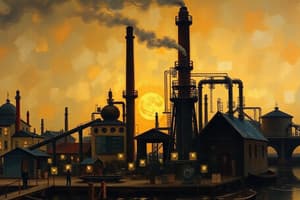Podcast
Questions and Answers
What are the two main classes of hydrocarbons found in petroleum?
What are the two main classes of hydrocarbons found in petroleum?
Open-chain (aliphatic) compounds and ring compounds.
Describe the difference between n-paraffin and isoparaffin series.
Describe the difference between n-paraffin and isoparaffin series.
N-paraffin series consists of straight-chain alkanes, while isoparaffin series consists of branched-chain compounds.
What is the empirical formula for the olefin series found in crude oil?
What is the empirical formula for the olefin series found in crude oil?
$CnH_{2n}$
Identify one example of a naphthene compound and its formula.
Identify one example of a naphthene compound and its formula.
What makes aromatic compounds distinct from other hydrocarbon classes?
What makes aromatic compounds distinct from other hydrocarbon classes?
How is the separation of petroleum products achieved during refining?
How is the separation of petroleum products achieved during refining?
What are the main components of natural gas found in underground reservoirs?
What are the main components of natural gas found in underground reservoirs?
What role do hydrocarbons other than carbon and hydrogen, like sulfur and nitrogen, play in crude oil?
What role do hydrocarbons other than carbon and hydrogen, like sulfur and nitrogen, play in crude oil?
What are light distillates primarily used for in the petroleum industry?
What are light distillates primarily used for in the petroleum industry?
How does the distillation process separate liquid mixtures in the petroleum industry?
How does the distillation process separate liquid mixtures in the petroleum industry?
What are intermediate distillates and give two examples?
What are intermediate distillates and give two examples?
Describe the main purpose of the absorption process in petroleum refining.
Describe the main purpose of the absorption process in petroleum refining.
What is the role of heavy distillates in refining?
What is the role of heavy distillates in refining?
Explain what cracking or pyrolysis achieves in the refining process.
Explain what cracking or pyrolysis achieves in the refining process.
What is the significance of filtration in the separation processes?
What is the significance of filtration in the separation processes?
List two substances included in the residues from petroleum refining.
List two substances included in the residues from petroleum refining.
What happens during the extraction process in petroleum refining?
What happens during the extraction process in petroleum refining?
Why is understanding the properties of fuel important in the context of high-compression motors?
Why is understanding the properties of fuel important in the context of high-compression motors?
Flashcards are hidden until you start studying
Study Notes
Constituents of Petroleum
- Crude oil is composed of various chemicals, including methane, propane, and asphalt.
- Hydrocarbons are classified into two categories: open-chain (aliphatic) compounds and ring compounds.
- Besides hydrocarbons, crude oil contains elements such as sulfur, oxygen, and nitrogen.
Open-chain or Aliphatic Compounds
- N-paraffin series (alkanes): Formula CnH2n+2; predominant in most petroleum fractions.
- Isoparaffin series: Branched-chain alkanes, desirable for fuels; naturally occurring examples include 2- and 3-methylpentane.
- Olefin/Alkanes series: Formula CnH2n; found in small amounts in crude oil; produced via cracking; exhibit suitable anti-knocking properties (e.g., ethylene, propylene).
Ring Compounds
- Naphthene or Cyclo-alkanes series: Formula CnH2n; the second most abundant in crude oil; all members are saturated (e.g., cyclohexane).
- Aromatic series: Formula CnH2n-6; contain double bonds and present in small amounts; known for high anti-knocking characteristics (e.g., benzene, toluene).
Products of Refining
- Petroleum products are separated through fractionation, organized by boiling ranges.
- Natural Gas: Accumulates in reservoirs; primarily hydrocarbons from methane to propane; includes CO2 and nitrogen.
- Light Distillates: Comprise gasoline, jet fuel, kerosine, and light heating oils; critical for high-compression motor use.
- Intermediate Distillates: Include gas oil and diesel; often mixed with heavy tar for viscosity reduction.
- Heavy Distillates: Hydrocracked into lighter distillates; used for lubricating oils, mineral oils, and waxes.
- Residues: By-products such as residual fuel oil and petroleum coke; utilized in electrodes and various industries.
Manufacture / Refining Process
- Major processes in refining petroleum include physical changes (separation) and chemical changes (conversion).
Separation Processes / Operations
- Distillation: Primary method for separating liquid mixtures based on volatility; involves vapor rising and liquid descending in a column.
- Absorption: Counter-current flow where gas and liquid interact; used for gas purification.
- Adsorption: Separation where molecules migrate from liquid/gas to a solid adsorbent; effective for removing trace components.
- Extraction: Uses a solvent to separate components from liquid mixtures; requires immiscible feed and solvent.
- Filtration: Separates solids from liquids using porous media; common in the chemical industry.
Conversion Processes
- Cracking/Pyrolysis: Breakdown of large hydrocarbons into smaller molecules using heat or catalysts; key for gasoline production.
- Polymerization: Process to create large molecules from smaller units; essential in petrochemical manufacturing.
Studying That Suits You
Use AI to generate personalized quizzes and flashcards to suit your learning preferences.




